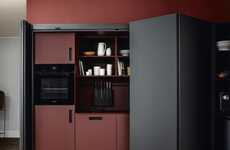
Reform's Kitchen Wood and Steel Cabinetry Doesn't Need Screws
Laura McQuarrie — May 19, 2020 — Art & Design
References: reformcph & fastcompany
Screws are usually integral to assembling cabinetry designs but Reform is introducing wood and steel cabinetry pieces that can be put together without any extraneous fasteners. The easy-to-assemble kitchen cabinets are modular and can be customized to one's liking with different drawer and shelf arrangements. Thanks to the way the cabinets are milled, using a traditional wood joinery technique, they interlock seamlessly like puzzle pieces.
The process of putting the kitchen cabinets together is so simple that Reform CEO and founder Jeppe Christensen claims "My son, who is two and a half, can do it."
At a time when people may find that they're doing more home projects around the house by themselves, this kitchen cabinetry system promises to be especially appealing for those who don't want to fuss with nails and screws.
Image Credit: Reform
The process of putting the kitchen cabinets together is so simple that Reform CEO and founder Jeppe Christensen claims "My son, who is two and a half, can do it."
At a time when people may find that they're doing more home projects around the house by themselves, this kitchen cabinetry system promises to be especially appealing for those who don't want to fuss with nails and screws.
Image Credit: Reform
Trend Themes
1. Fastener-free Cabinetry - The trend towards designing cabinetry without screws or nails allows for seamless and easy assembly using traditional wood joinery techniques.
2. Modular Cabinetry - The modular design of cabinets facilitates customization and allows for greater flexibility in creating unique interiors.
3. User-friendly Cabinetry - The growing demand for DIY home improvement projects that are easy to execute has increased the popularity of cabinets that don't require any extra tools or expertise to assemble.
Industry Implications
1. Home Improvement Retail - Retailers can harness the trend of fastener-free cabinetry designs by developing DIY kits that are user-friendly and don't require additional hardware to assemble.
2. Interior Design - Designers can incorporate modular cabinetry systems to create bespoke interiors that are both functional and aesthetically pleasing.
3. Woodworking - The use of traditional wood joinery techniques to create cabinets without screws or nails represents an opportunity for woodworking artisans to showcase their craft and develop innovative methods for creating seamless furniture pieces.
5.8
Score
Popularity
Activity
Freshness























